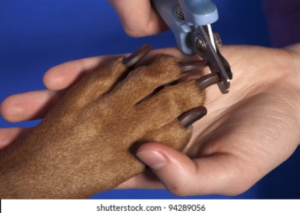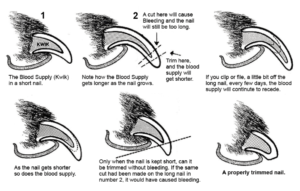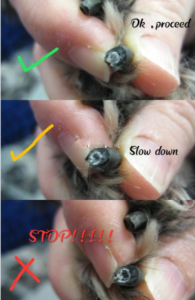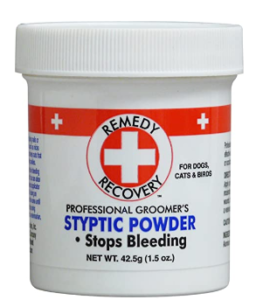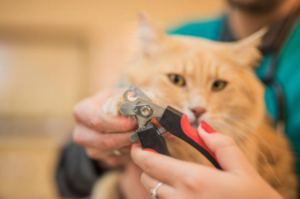Let’s Talk Toenails!
Hello again friends of GVH! Today I wanted to discuss something very basic, but very important – toenail maintenance for dogs and cats. Generally, we recommend regular trims for dogs and cats, although cats that are mostly outdoor and may have to fend off predators or climb trees to escape can have long nails as long as there aren’t extra nails in between their toes and the nails aren’t curling in. It’s really important to get dogs and cats used to you handling their toes and nails as puppies as kittens when possible, but we understand that some furry family members aren’t adopted until after they have become adults. Some cats and dogs don’t mind the toenail trims, but others really seem to have an aversion to it, and it’s not always clear why.
If you are attempting to trim nails for the first time or with a dog or cat who isn’t thrilled with the process, I would recommend just doing one toenail at a time, maybe one per day, and immediately giving a reward during or after. If you do just one nail per day instead of fighting through one or more paws all at the same time, it’s much less of a big deal. Follow it with a treat and make it a daily part of your schedule – part of cuddle time on the couch, or right before dinner time – and then it’s just a low key, normal part of their day.
If you have never trimmed a dog’s nail before, here is a good link that goes over the basics:
https://www.vetbabble.com/dogs/grooming-dogs/trimming-dogs-nails/
I particularly like the diagram of the kwik from the above article, which I’ll post here:
This diagram explains that as the nails grow, the kwik grows with it. The kwik is the blood vessel of the nail, and it can be seen in clear nails but not in black nails (unless you hit it while trimming). A nerve runs along with the blood vessel, so it is both slightly bloody and slightly ouchy if you hit the kwik. However, do not be intimidated! By taking little bits at a time and checking the nail in between, you can often identify a slight hole or dark spot in the cut surface of the nail where the kwik lives before you actually hit the kwik, and if you see it starting you know it is time to stop trimming. And if you do accidentally go too far and hit the kwik, even though everyone will feel bad for a few minutes and you may need to apply a little styptic powder and do a little clean up, everyone will be okay.
Photo: quora.com
Another way to trim nails in dogs is a Dremel – that grinds the nail down. It takes more time but can be less scary for the owner as long as the dog is okay with the feel and the sound. Some dogs wear down their own nails from walking on pavement, which is great – as long as any toes that don’t hit the ground, such as the dew claws (or “thumbs”) are regularly trimmed.
Nail maintenance is very important for young, active dogs – because nobody likes unexpected trips to the vet for a torn nail that got stuck on something while playing – but it gets even more important as dogs and cats get older – young and middle aged cats may scratch furniture or scratching posts to shape their nails, but as they age their nails don’t always shed the right way and can end up with very thick “old lady” or “old man” nails. For both cats and dogs, we don’t want their nails to curl back and grow into the toe pads because that is painful and can cause infection.
Source: istockphoto.com
If you are still not interested in trimming your own dog or cat’s nails, you’re in luck! This is your local groomer’s specialty. Mobile groomers can come to your house and trim your dog or cat’s nails, and you can also take your pets to brick and mortar groomers nearby. It is a great idea to do this regularly so that it’s routine, which makes it lower stress than if it’s just something that you set up and dread once or twice a year.
Finally, as a last resort, you have the veterinary hospital. We will often do a nail trim during a wellness appointment when asked, and we can have pets come in for nail trims as in-back appointments. But remember, we are an animal hospital. Your dog or cat has to come see us for shots, illness, and injuries. Since nail trims are often just one more stressor, it is a good idea to have them done elsewhere if it’s possible – that way it’s not associated with their experience in the hospital. It is often a much less stressful experience at a groomer – especially a mobile groomer – where there aren’t potentially a lot of other sick animals, or animals waking up from surgery and potentially being loud, as well as the smells of an animal hospital. It’s just an overall better experience for your pet. We’re here if you need us! But try it at home or working with a groomer first.
If you have questions or concerns about the health of your dog or cat’s nails, you feel like their anxiety with nail trims is high, or they lash out during nail trims (growling, hissing, scratching, biting), please don’t attempt it without talking with a staff member here at GVH first – we may be able to offer tips or even a mild anti-anxiety medication that can be given before a nail trim to help relax them. We’re here for you at 203-453-2707.
–Dr. Dana Muir

